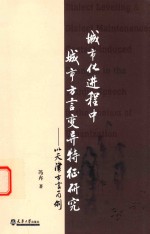

城市化进程中城市方言变异特征研究 以天津方言为例 英文PDF格式文档图书下载
- 购买点数:9 点
- 作 者:冯卉著
- 出 版 社:天津:天津大学出版社
- 出版年份:2015
- ISBN:9787561853580
- 标注页数:176 页
- PDF页数:197 页
Chapter 1 Introduction 1
1.1 Dialect Contact Studies:An Emergent Field of Enquiry 1
1.2 Globalization and the Changing Tiānjīn Dialect 2
1.3 Layout of the Book 3
Chapter 2 Language Variation and Change:From Traditional Dialectology to Social Dialectology 5
2.1 The Western Tradition in the Study of Language Variation and Change 5
2.1.1 Historical Linguistic Studies:Achievements and Limitations 6
2.1.2 Sociolinguistic Perspectives 7
2.1.2.1 Variationist Approach 8
2.1.2.2 Social Network Theory 11
2.1.3 Dialect Contact 12
2.1.3.1 Language Contact versus Dialect Contact 12
2.1.3.2 Traditional Dialectology versus Social Dialectology 14
2.1.3.3 Theory and Principles for Dialect Contact 16
2.1.3.4 Processes/Mechanisms of Dialect Contact 18
2.2 The Study of Language Variation and Change in the Chinese Context 20
2.2.1 Philological Studies 20
2.2.2 Sociolinguistic Studies 21
2.2.3 Studies on Tiānjīn Dialect 23
2.2.3.1 Salient Features of Tiānjīn Dialect 24
2.2.3.2 Sociolinguistic Studies on Tiānjīn Dialect 29
2.2.4 Dialect Contact Research 30
2.2.4.1 Deficiencies of Traditional Chinese Dialectology 30
2.2.4.2 Dialect Contact—An Emergent Field of Inquiry in China 31
2.2.4.3 Limitations of Previous Sociolinguistic Researches on Tiānjīn Dialect 33
Chapter 3 The Proposed Framework 35
3.1 Pilot Study 35
3.2 The Framework 36
3.2.1 Language Ideology 40
3.2.2 Linguistic Market 41
3.3 Dialect Leveling 42
3.3.1 Standard Linguistic Market 43
3.3.2 Loose-knit Social Network 46
3.3.3 Process of Long-term Accommodation 48
3.4 Dialect Maintenance 48
3.4.1 Globalization and Local Culture 49
3.4.2 Close-knit Social Network 50
3.4.3 Vernacular Linguistic Market 50
3.5 Summary 52
Chapter 4 Variables and Data Collection 53
4.1 Social Variables 53
4.1.1 Demographic Variables 53
4.1.1.1 Sex 53
4.1.1.2 Age 54
4.1.1.3 Occupation 55
4.1.1.4 Level of Education 56
4.1.1.5 Workplace 57
4.1.1.6 Length of Service 58
4.1.2 Sociopsychological Variables 59
4.1.2.1 Attitude towards Tiānjīn Dialect 59
4.1.2.2 Frequency of Contact with Pǔtōnghuà 62
4.1.2.3 Frequency of Using Pǔtōnghuà at Work 64
4.2 Linguistic Variables 65
4.2.1 Lexical Items 65
4.2.2 Consonants 66
4.2.3 Application of FF Rule 67
4.3 Data Collection 67
4.3.1 Observer's Paradox 67
4.3.2 Selecting Informants 68
4.3.3 Collecting Data for Consonants and FF Rule 70
4.3.4 Collecting Data for Lexical Items 71
Chapter 5 Data Analysis,Findings and Discussion 74
5.1 Construction of the Lexical Items 75
5.2 Relations between AGE/SEX/OCC/EDU and Linguistic Variables 77
5.2.1 AGE with Linguistic Variables 78
5.2.2 EDU with Linguistic Variables 82
5.2.3 SEX with Linguistic Variables 84
5.2.4 OCC with Linguistic Variables 85
5.2.5 MODEL-1 with Four Demographic Variables 87
5.3 Relations between WP/LoS and Linguistic Variables 89
5.3.1 WP with Residuals of Linguistic Variables 89
5.3.2 LoS with Residuals of Linguistic Variables 91
5.3.3 MODEL-2 with Six Demographic Variables 92
5.4 Relations between ATT/SOCNET1/SOCNET2/FREQ and Linguistic Variables 94
5.4.1 Relations between ATT and Linguistic Variables 95
5.4.2 Relations between SOCNET1/SOCNET2 and Linguistic Variables 96
5.4.3 Construction of SOCNET 99
5.4.4 Relations between FREQ and Linguistic Variables 100
5.4.5 MODEL-3 with Sociopsychological Variables 101
5.5 Effect of WP on ATT,SOCNET1 and FREQ 103
5.6 MODEL-4 with All Significant Variables 104
5.7 Linguistic Variations in Different Styles 109
5.8 The Group of Informants with the Most Features of Tiānjīn Dialect 111
5.9 Change in Progress? 116
5.9.1 Lexical Change in Progress 116
5.9.2 Peculiar Consonant Change in Progress 118
5.9.3 FF Rule Change in Progress 123
5.10 Summary 127
Chapter 6 Conclusion 130
6.1 The Changing Tiānjīn Dialect in the Context of Globalization 130
6.2 New Issues and New Directions for Research on Dialects in Contact 133
Appendix 1:Questionnaire 135
Appendix 2:Lexical Items(161 Words) 137
Appendix 3:The Salient Lexical Items(100 Words) 142
Appendix 4:Passage Reading 146
Appendix 5:Models with and without the Retired Informants 147
References 151
Acknowledgements 174
- 《城市化进程中城市方言变异特征研究 以天津方言为例 英文》冯卉著 2015
- 《宣化方言及其时空变异研究》郭凤岚著 2007
- 《汉语阳泉方言语音变异研究》李伟著 2010
- 《苏州郊区方言研究》林齐倩著 2017
- 《方言变异与变化 溧水街上话的调查研究》郭骏著 2009
- 《无锡方言接触研究》曹晓燕著 2015
- 《山西大同县东南部方言及其变异研究》武玉芳著 2010
- 《城市化进程中村落变迁的特征概括和规律分析》任映红著 2017
- 《汉语方言在海外的播迁与变异 第四届海外汉语方言国际研讨会论文集》陈晓锦主编;甘于恩副主编 2016
- 《语言生活与语言变异 河间方言的社会语言学研究》谢俊英著 2013
- 《日本占领天津时期罪行实录》郭登浩,周俊旗主编 2016
- 《天津通志 出版志》天津市地方志编修委员会编著 2001
- 《天津出版史料 第2辑》孙五川等主编 1990
- 《天津出版史料 第1辑》孙五川,林呐主编 1988
- 《天津市出版科研论文集 2006》天津市出版工作者协会编 2007
- 《天津人民美术出版社藏画选》 1984
- 《天津人民美术出版社藏画 陈少梅 第2版》陈少梅绘 2008
- 《嘛叫天津人 历史篇》孙福海著 2017
- 《天津年画百年》张道梁编 2004
- 《天津人民美术出版社藏画 任伯年》任伯年绘 2004
